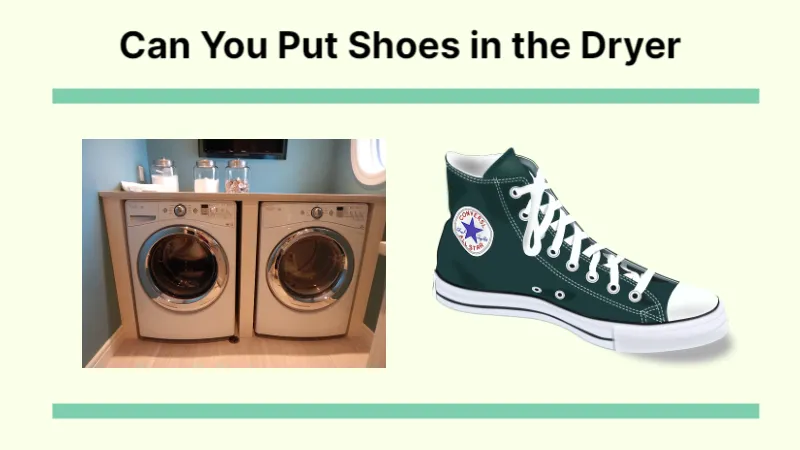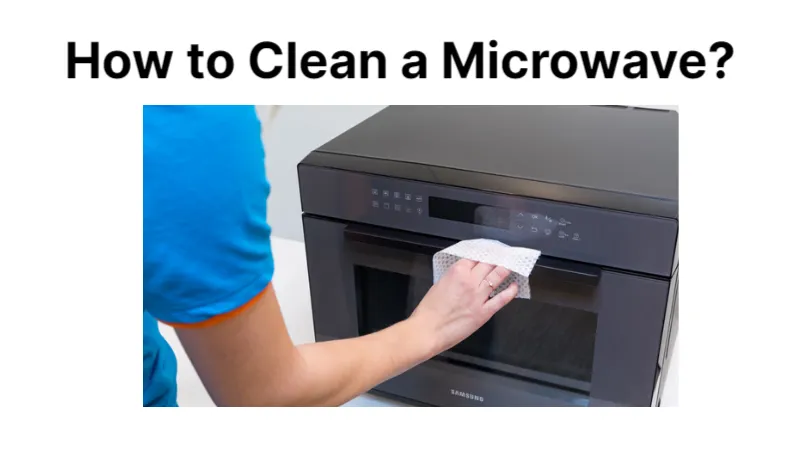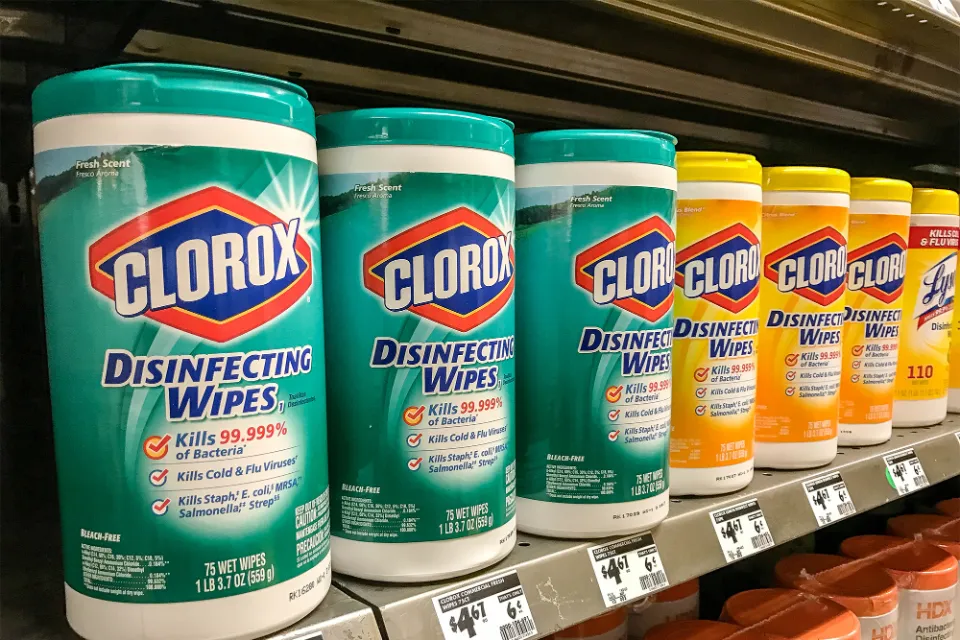But, can you put shoes in the dryer? And more importantly, should you?
Yes and no, respectively. You can dry wet shoes in the dryer, but you should be cautious to prevent damage. This is so that you can avoid damaging some materials by washing them according to the manufacturer’s instructions.
Can You Put Shoes in the Dryer?
No, you shouldn’t dry your shoes in the dryer. The likelihood that the fabric of your sneaker will change, warp, and stretch when you dry it in a dryer is too high. The heat (learn how hot does a dryer get) and constant tumbling will put stress on your shoes that they were not made to endure.
I would only suggest you use a dryer when using an old pair of shoes, and making sure the tumble dry setting is low. where using the shoes differently than how they originally looked and felt has no negative effects.
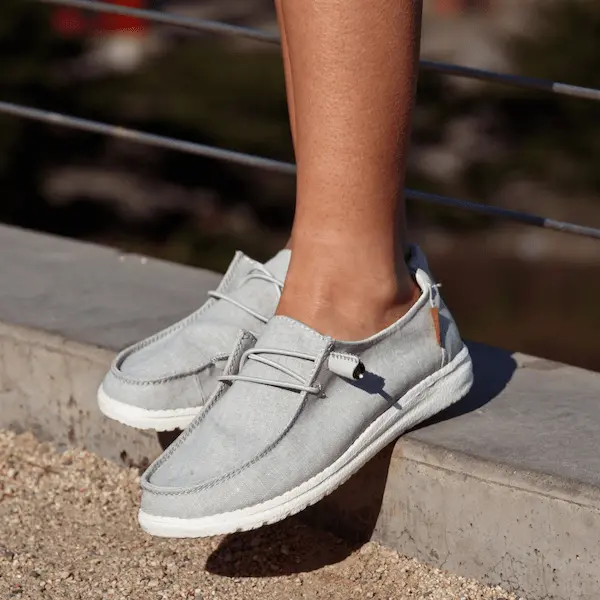
The Correct Way to Put Shoes in the Dryer
Here are the details:
Check the Manufacturer’s Recommendations
The majority of shoes have a label inside that describes how to take care of them. Information on sizing, materials, and the location of the shoes’ manufacture are usually all found on the same label. The best practices for taking care of your shoes can be found in those cleaning instructions.
These symbols indicate whether you can bleach or wash your shoes and how to dry them. These labels are frequently small and don’t provide full explanations. If you are unfamiliar with the symbols, you can check out a comprehensive guide here.
Remember that some producers won’t provide that information at all. The best course of action in those circumstances is to hand wash and air dry the shoe.
Understand How Different Materials Respond to the Drying Process
Nylon and Polyester
Given how flexible nylon and polyester are, they are typically used to make athletic and running shoes. It typically appears in proportions that improve specific performance characteristics of the shoes rather than being the primary component of the shoe.
A low heat setting is essential when drying shoes made of these materials to prevent damage. For machine drying polyester, the lowest temperature is needed to avoid shrinkage.
Another helpful suggestion is to treat nylon/polyester clothing according to standard guidelines.
Canvas
Due to their durability and light weight, canvas shoes are quite popular. The good news is that because it is the same material used to make tents, it can withstand high dryer heat effectively. As a result, you can dry your clothes while wearing canvas shoes without fear of damage.
Having said that, you should always take into account the other materials used to make the shoe, such as the metal lace rings and rubber or plastic soles.
The likelihood of the sneakers contracting or warping is, overall, quite low. Therefore, the majority of your dryer’s moderate settings will be fine.
Rayon
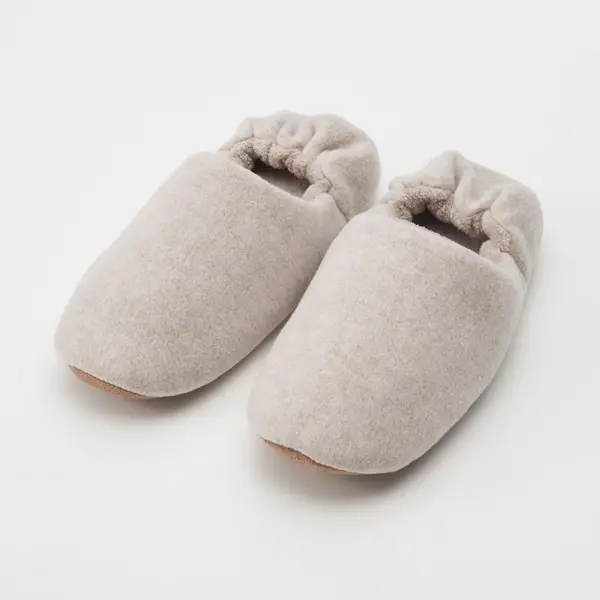
A semi-synthetic fabric made of wood pulp is rayon. You end up with cellulose fibers that have been thoroughly cleaned and are excellent at absorbing moisture while still remaining breathable. Because of this, rayon is frequently used for running and athletic shoes.
But it’s crucial to remember that in extreme heat, it can easily deteriorate, stretch, or contract. Your athletic shoes could burn, rendering them unwearable even though rayon won’t melt.
Avoid using the washing and drying machines if your shoes are rayon.
Leather (cowhide and Sheepskin)
Anything made of animal products, including leather, ages poorly in hot environments. Even though it takes some time, eventually, the process will result in obvious wrinkles and creases. As the shape deviates further from the original, leather shoes will no longer be wearable.
In addition, exposure to extreme heat can cause leather tennis shoes and running shoes to discolor. Hand washing and air drying are the best practices when it comes to leather items in general.
Suede
For suede shoes, which are made of a delicate material, air drying is the best option. To begin with, dress shoes can be impacted by excessively cold or hot temperatures.
The suede may become stiff in extremely cold weather and may even break in large pieces. High temperatures, on the other hand, can result in warping and cracking. It is best to dry your shoes in the shade, away from the sun, to prevent damage.
Foam Or Gel
Even though the inside of the shoes is typically made of foam and gel, you should still consider this when deciding how to clean them. For instance, foam soles aren’t always detachable.
By damaging the internal glue and loosing the insoles, washing your sneakers could cause them to fall apart. Furthermore, the parts lose their integrity more quickly in the dryer because they are jostled around. Even at the lowest heat setting, the material can degrade.
Additionally, when exposed to heat, gel readily melts and warps. The shoe will eventually get harder and more brittle, which makes it more likely to crack when worn. Soaking wet footwear with gel or foam soles should be dried by air as much as possible.
Embellished Shoes
The embellishments on shoes with intricate, removable designs will come off if you dry them. The delicate items will be able to separate from the shoes in the dryer because they will be tumbled around while being dried by a machine. Consequently, it is best to let shoes with intricate and delicate designs air dry.
Cotton
Some shoe manufacturers put a strong emphasis on creating vegan products and provide organic cotton as an alternative. These shoes can shrink in the dryer even though it is generally safe to do so. The cotton shoes should be stuffed with small towels to stop that from happening so that they don’t shrink as they dry.
Choose the Right Settings
To avoid using extreme heat, set your machine to the Air Dry setting. If it’s the only setting available, you can use it.
A good way to monitor the process is to pause the cycle from time to time and feel the inside of the shoes to see if they are dry. If you think they’re almost finished, you can keep adding five-minute breaks.

How to Wash Shoes in the Washing Machine?
- Check the Tags.
Check tags (typically located under the tongue of the shoe) or the manufacturer’s website for suggested cleaning procedures before washing shoes in the washing machine. Even if you believe the shoes are machine washable, not all of them are. The appropriate handwashing techniques must also be used for certain materials. Make sure the shoe’s style and construction are suitable for your washing machine.
- Remove Laces and Insoles.
You should remove your shoes’ insoles and shoelaces. As many insoles are delicate, removing the laces is preferable because they can get tangled in the washing machine.
Hand-washing soap or liquid detergent, a soft brush, or a rag are all that’s needed to clean the laces and insoles. Before you put them back where they belong, give them time to completely air-dry. As an alternative, you could put your sneakers and laces in a mesh garment bag.
- Pre-treat the Soles.
To clean the soles of your shoes of any debris or dirt, use a soft brush.
- Load the Machine.
Put the shoes in the washing machine. Pro tip: Washing shoes with several old towels balances the load, prevents your shoes from banging around during the cycle, and guarantees that the dye from the new towels won’t affect your shoes.
- Start Wash.
Remember that a delicate, cold-water cycle is ideal when learning how to wash shoes in a washing machine because it will help keep your shoes safe. Avoid using powder detergent because it can clog shoelace holes and shoe soles. Alternatively, use laundry pods or liquid detergent.
- Air-dry Your Shoes.
Drying your shoes is necessary after the wash cycle is finished.
However, a word of caution: Avoid drying your shoes in the dryer. The glue that holds shoes together can be harmed by dryer conditions. High heat can even cause some materials or fabrics to shrink, permanently warping your shoes and impairing their performance and fit.
Find a place that is cool, sunny, and has good ventilation, and leave your shoes there to dry properly. To help your shoes maintain their shape while they dry, stuff some tiny towels inside of them. In general, you should only wash your shoes when you have enough time to let them air-dry completely. If not, you are merely providing a moist environment for unfavorable bacteria to flourish. You can direct a fan or blow dryer at your sneakers if you need to make things happen more quickly.
- Reassemble.
Reinstall the soles and laces after your shoes have been cleaned and dried. Rock your spotless shoes after that.
The kind of crocs you own will affect how you should wash them. Can you put crocs in the washing machine? To avoid damaging your crocs when washing them, you should first read this post.
Suggested reading: Even though Vans shoes are built to withstand the abuse of skateparks, they occasionally need some tender loving care. Here’s the question, can you put vans in the washing machine?
Q&A
How Do You Clean Muddy Shoes?
To keep them in good condition, shoes that are covered in mud or dirt will require an extra level of care.
Mud can hinder a shoe’s ability to provide traction if it is covered in it.
Before washing your shoes with soap and water, remove any remaining dirt and grime with an old toothbrush.
How Do You Clean Shoe Soles?
During a run, your shoe soles soak up a lot of sweat, which bacteria love!
Bacteria = smelly shoes
Place your soles inside an old pillowcase and wash on cold/delicate.
They’ll smell minty clean after doing this!
How Do You Clean the Bottom of Shoes?
Use a brush to remove extra dirt from the bottom of your shoes before wiping them down with a damp washcloth to prevent the accumulation of mud, dirt, and grime.
When cleaning off dirt and grime, avoid getting the shoe wet.
How Do You Clean Gore-Tex Running Shoes?
Use a specialist footwear cleaner for running shoes with a breathable membrane like Gore-Tex.
This is because soapy water has a tendency to make Gore-Tex sticky.
Read about
Summary: Can You Put Shoes in the Dryer?
The answer is yes or no. You can put wet shoes in the dryer, but you should be careful to make sure they don’t get damaged in the drying process. This is because certain materials can be damaged if you do not follow the manufacturer’s washing instructions.
Thank you for reading.
